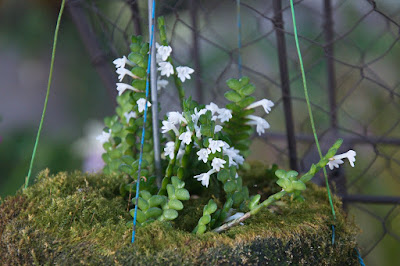Angraecum distichum is native to Angola, Burundi, Cameroon, Central African Republic, Congo, Côte d'Ivoire, Equatorial Guinea, Gabon, Ghana, Guinea, Guinea-Bissau, Liberia, Nigeria, Rwanda, Senegal, Sierra Leone, Uganda. It grows epiphytic on large trees in rain forests at an altitude of 200 to 1600 meters above sea level...
Angraecum distichum also called as The 2-Rowed Angraecum, Aeranthes distichus, Angraecum imbricatum, Angraecum poppendickianum, Dolabrifolia disticha, Dolabrifolia poppendickiana, Epidorchis disticha, Limodorum imbricatum, Macroplectrum distichum, Mystacidium distichum, is a species of the genus Angraecum. This species was described by John Lindley in 1836.
IDENTIFY ANGRAECUM DISTICHUM ORCHID PLANT
Angraecum distichum is native to Angola, Burundi, Cameroon, Central African Republic, Congo, Côte d'Ivoire, Equatorial Guinea, Gabon, Ghana, Guinea, Guinea-Bissau, Liberia, Nigeria, Rwanda, Senegal, Sierra Leone, Uganda. It grows epiphytic on large trees in rain forests at an altitude of 200 to 1600 meters above sea level.
It is a miniature to small sized, hot to cool and humid growing epiphyte with leafy stems that form large clumps and carrying distichous, falcately oblong-elliptic, bilaterally compressed, 10-15 cm long leaves.
The 2-Rowed Angraecum blooms on a very short, axillary, solitary flowered inflorescence with a long-lived, small, fragrant flower occuring in the summer on new leaves and most often more than one. The flowers are fragrant, white, about 0.5 cm in diameter, appear directly from the sinuses between the leaves. Petals are oval, slightly pointed, at the base fused with sepals, thus forming a kind of tubule. The lip is, as it were, an extension of this tubule, has a pointed tip, the edge is slightly curved inwards.
ANGRAECUM DISTICHUM ORCHID PLANT CARE AND CULTURE
Cultural information should only be used as a guide, and should be to be adapted to suit you. Your physical location; where you grow your plants, how much time you have to devote to their care, and many other factors, will need to be taken into account. Only then can you decide on the cultural methods that best suit you and your plants.
Light:
Angraecum distichum loves bright sunlight and is able to tolerate direct morning and evening sun, however, in the hot summer noon (especially in the windows of southern orientation), the orchid should be protected from direct sunlight: put behind a curtain (for example, on a table near the window) or in the shade of other plants, otherwise the plant can get a sunburn.
Temperature:
This type of orchid refers to a moderately warm temperature regime, and throughout the year the plants are recommended to be kept under the following temperature conditions: Day temperature at 18-24 ° C (maximum 28 ° C); Night temperature at 13-16 ° C. To successfully grow at home, it is necessary that the night temperature of the content is always at least 5 ° C lower (ideally 7-10 ° C) than the daytime temperature.
Humidity:
The 2-Rowed Angraecum needs the humidity level of 60-65% (ideally 70-80%). Too dry air negatively affects the overall development of the plant - its growth is inhibited, roots begin to dry out, and the leaves become flabby and turn yellow.
Substrate, growing media and repotting:
Angraecum distichum can be grow in pots and hanging baskets, and placed on blocks or simply in empty wicker baskets. As a substrate, a mixture of bark of coniferous trees with charcoal is best. At the bottom of the pot is recommended to lay a thick layer of drainage. When growing orchids on blocks to prevent rapid drying of the root system of the plant, it is recommended to make a small interlayer of moss between it and the block. Above the roots, you can also put live or dry sphagnum.
The 2-Rowed Angraecum reacts extremely negatively to the repotting and may not bloom after 1-2 years, therefore it is recommended to replant the plant only when it is really necessary. For example, in cases of severe salinization or compaction of a substrate, too high or low pH, etc. The best time for transplantation is the spring period.
Watering:
Watering this kind of orchids directly depends on the total temperature of the content, the higher it is, the more often and abundant it will be necessary to water. Plants that grow without a substrate must be watered daily in the morning so that by evening the roots of the orchids can dry out relatively well. When watering orchids in pots, it is necessary to remember that excess water during watering should flow freely out of the pot, as the stagnation of water both inside the pot and in its pallet can very quickly lead to rotting of the roots and the lower part of the plant. The substrate between waterings should dry up relatively well.
Fertilizer:
During the new growth period, this type of orchid is fertilized every 2 weeks in 1/2 or 1/4 of the fertilizer concentration indicated on the package. In addition to the usual root top dressing, it is also recommended to produce a foliar dressing, when a very much diluted fertilizer is sprayed on the outer part of the plant. It is best to feed the orchid, alternating both these methods. The best fertilizer is fertilizer containing nitrogen, phosphorus and potassium in equal parts, for example, NPK = 3-3-3 or 8-8-8. If you do not have such fertilizer, then at the beginning of the growing season (the appearance of new leaves), feed the orchid fertilizer with a large content of nitrogen, and a little later - fertilizer with a higher content of phosphorus.
Rest period:
Angraecum distichum does not need a period of rest to stimulate flowering. After flowering, the peduncles are removed, cutting them to the very base, if necessary, the orchid is transplanted and kept completely dry for some time. This is necessary to acclimatize the plant and to prevent rotting of the roots from the transplant.















COMMENTS